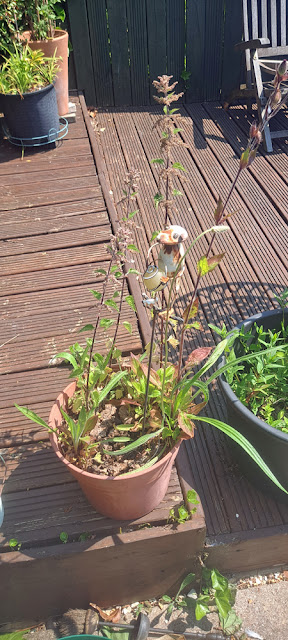Rose
Wild most places. Woody, bushy. Produce hips, insect pollinated, seeds dispersed by birds.
Domesticated by cutting - cloning. So, for the flower and not food. Originally leisured elite as demonstration of power and wealth. Also for scent, oil and attar for hygiene issues.
Now the most popular cut flower. A gift as an expression of love and desire - Greek Aphrodite and Roman Venus; gods of love, lust, beauty, pleasure, passion, procreation. Now also Valentine's. Purity in religion as well - Virgin Mary, the rosary, Rose Windows (Chartres, York), Islamic gardens.
Common symbol - see below. Socialism too after French Revolution (1848).
A film - 'The Name of the Rose' with Sean Connery.
A saying - 'smell the roses' - a short escape from the cares of work and family.
 Tudor Rose
Tudor Rose
Created in the wake of England's Wars of the Roses, fought between the houses of Lancaster and York, as they claimed, reclaimed and ousted one another from the throne. The name 'War of the Roses' was awarded by Henry VII after the event. He chose the red and white colour scheme for his Tudor rose when he married Elizabeth of York in January 1486.
Yorkshire Cricket Rose
Lord Hawke, in the early days of his captaincy, designed the white rose badge. It is not a real flower. Based on a hedge rose, the eleven petals represent the players.
Foxglove
Latin - digitalis. Poisenous. First described by Leonard Fuchs of fuchsia fame 1542.
1785 first reported for treatment of dropsy by William Withering. Active ingredient is digoxin - slows heart rate in atrial fibrillation and improves heart muscle function in heart failure. Therapeutic dose close to toxic so easy to overdose.
No one knows who or how discovered. A herbal remedy, many of which attributed to 'wise woman' who understood plant secrets. Is it magic or science? Sadly many a witch suffered.

Bamboo
This is a ragged specimen but it is bamboo.
Its main attribute is strength and often seen in Chinese construction sites.
Fast growing up to 10ft tall and 1 ft diameter.
Loads of other uses - weapons (sticks and spears),
musical instruments, baskets, furniture, fishing traps
and poles, floating houses, food, garments.
Home to the giant panda.










